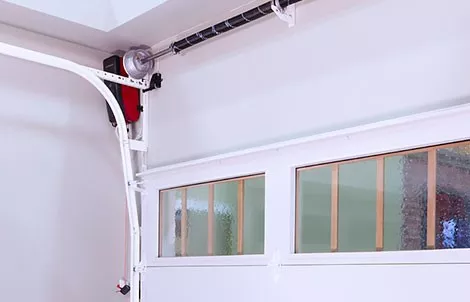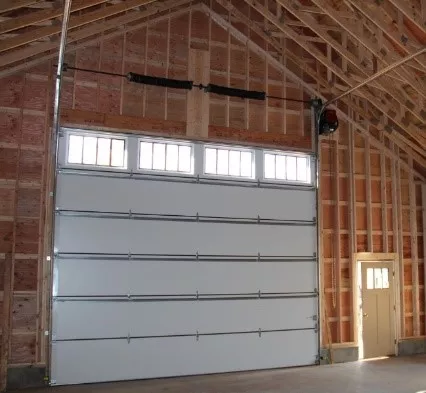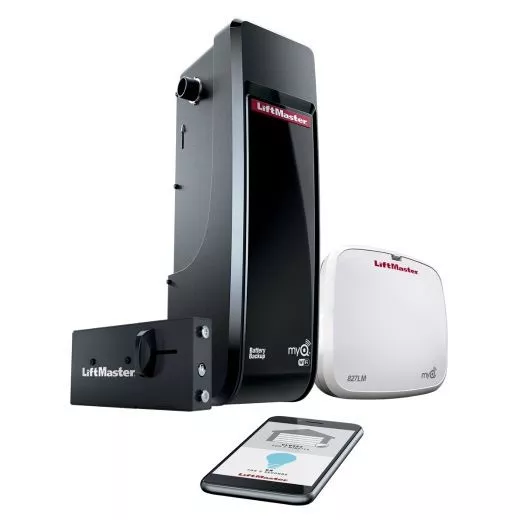If you take a look at home design over the past few years, you’ll find that one thing is true – garages just keep getting bigger and bigger. In the past, these were utilitarian spaces with low ceilings, and barely enough room to park a small car. Today, they have higher ceilings and wider spaces. Often, the ceiling can be 9 feet high, and ceilings of 12 and 14 feet are increasingly common. When you install a conventional garage door that’s only about 7 or 8 feet tall in one of these spacious garages, it means you’ve got a lot of leftover room over the top of the dor. What do you do with it?

LiftMaster/Chamberlain, a leading innovator in the garage door opener industry, has a solution to that challenge. The company took their commercial garage door opener system and adapted it for use within residential homes. The result is a door opener with a secondary shaft, or a jackshaft garage door opener.
What does that mean, exactly?
There are several differences between a conventional, trolley‑style garage door opener and a jackshaft‑style garage door opener. However, the most visible one is installation location. While a trolley‑type opener is mounted to the middle of the ceiling, a jackshaft opener is mounted beside the door itself. In most situations, the door will be between 7 and 8 feet wide, and there will need to be about 24 inches of room over the door.
This is actually a common scenario with newly constructed homes where the builder was hoping to provide additional storage space in the garage, or where the builder added cathedral ceilings to the garage. That allows homeowners to avoid installing a storage shed in the back yard, as their garage has more than ample room for their extra belongings.
There are also additional benefits to be found with a jackshaft opener. For instance, you can move the garage door as high as possible, opening up room on the walls for cabinets, hooks, and other storage solutions. You might also find it beneficial to use a jackshaft opener in a couple of other situations, such as:
- If you have low headroom over your garage door, but there’s enough space to the side, you can install a jackshaft opener on the side of the door. This is more common with older homes that do not have high ceilings in the garage.
- If you have a transom‑style window over the garage door, or if there’s a false panel in place, the builder might have chosen to install a fixed window above the garage door instead of on the garage door itself. A high‑lift type track system is not visible in this situation.
- Note that a jackshaft‑style opener can operate a garage door no more than 14 feet tall and 18 feet wide, with a general use frequency of two to four cycles per day. This makes them a good fit for garages where RVs are stored.

Jackshaft Opener Requirements
In order to install a jackshaft garage door opener, you’ll need to make sure that your garage meets the minimum requirements. These are as follows:
- A minimum of 8 inches to one side of the door
- A minimum of 3 inches of headspace above the door
- A torsion‑type spring lift system in which the jackshaft slips into the opener housing and is turned, thereby opening and closing the door
- An available electrical outlet within 6 feet of the opener
- Enough space for a 16.25‑inch opener housing
Advantages Over Trolley‑Style Openers
- Additional Space: You get more room because the door can be moved as close to the ceiling as possible. That provides additional space for storage.
- Quieter Operation: Jackshaft openers are direct current devices, which are quieter than alternating current systems. They start slowly, increase to normal speed, then slow down once more. If there is a bedroom located above or to the side of the garage, this can help reduce noise‑related disturbances.
- Cathedral Ceilings: If your garage has cathedral ceilings, the space may be too great for a trolley‑style garage door opener without the addition of a triangular‑shaped bracket that may be dangerous. In this instance, a jackshaft opener is the only option.
- Safety: Because a jackshaft opener is installed beside the door, there is less chance that it will fall on a vehicle or a person. Additionally, a jackshaft opener prevents thieves from being able to trip the safety release mechanism found on some trolley‑style openers.
- Battery Backup: The 8500W model includes an emergency battery that will open and close your door in case of a power outage. You’ll get roughly 20 uses before it needs to be recharged.

Other Features of Note
In addition to what we’ve discussed thus far, it is also important to understand some additional features that you’ll have access to with a jackshaft garage door opener that are also standard on trolley‑type openers:
There are some other features that are worth mentioning. Many of these are also found in trolley‑type openers:
- MyQ technology that allows you to operate the garage door from your smartphone
- Photo‑eye reversal system
- Emergency cord disengage system
- Security+ 2.0 system
- LED lighting with the 8500W model that can be installed almost anywhere in the garage
- Access to additional accessories to make life easier

Ready to know more?
If you’re in the Ellington area, get in touch with us by calling 1‑877‑828‑5279. We will be happy to discuss anything you might want to know about electric garage door openers.

Comments
Jack Shaft Door Opener
What other hard wear do i need to get if i install a Jack Shaft Style opener on a conventional Cable Hoisted coil spring Door?
12' X 14'
Atlas-Coles Door Systems
Hi Chris, we do have more questions for you to provide the best answer. Can you give us a call at 860-668-7991? It will be easier over the phone.
Add new comment